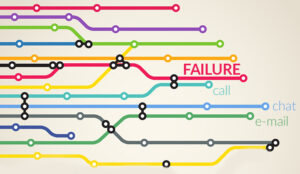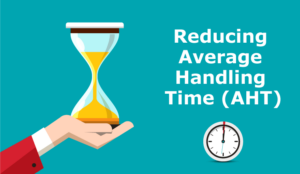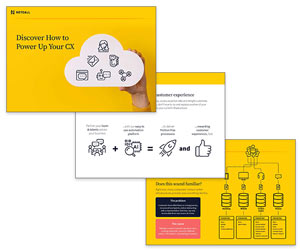The best way to reduce cost in a call centre is to reduce your Average Handling Time (AHT), right? Wrong!
Forget about your own call centre for a moment and think about your recent interactions with your bank, telecoms or utilities provider. Were you able to get what you wanted without having to chase, follow up or correct an error? If you are able to answer this with a yes, then count yourself lucky. Unfortunately for us as customers, call centre and customer experience professionals, the opposite is an all too familiar occurrence. What we are referring to here is of course Failure Demand.
Failure demand is a concept articulated most prominently by John Seddon of Vanguard Consult and defined as “demand caused by a failure to do something or do something right for the customer” (Seddon 2003). Failure demand in a call centre is typically around 40-60%.
If we have our agents taking calls all day long, and 40-60% of those calls are a result of our failure, then that is a whole lot of calls, cost and unhappy customers that are completely within our control.
Taking this back to my original statement relating to AHT. You might, with really hard work, reduce your AHT by 5%, maybe even 10% over a period of time. However, in most call centres you can reduce your overall demand by 30%+ by reducing your failure demand. Not forgetting the added benefit of improving your customer experience.
Understanding demand
To understand how much demand you have in your call centre is relatively straightforward. The great news is you do not need any expensive customer surveys or any focus groups. Actually, you don’t even need to bother the customer at all. Why? Because the information is right in front of you when the customer calls every day.
To provide a simple every-day scenario with two types of calls:
- “Can I change my address please.”
- “I called last week to change my address. However, it has not been updated on my account yet.”
Clearly the second bullet is the failure demand.
If you spend a little time listening to your calls and categorise those calls that are failure demand you can quickly understand the potential extra cost being added into your call centre and, more importantly, where you are letting the customer down.
A few pointers from my own experience to get good results in understanding your failure demand:
- Limit the amount of people capturing demand. It is quite common in call centres to undertake large-scale manual data gathering by agents to capture first point of contact, call types, etc. The tendency here would be to add some form of failure demand capture to all contact centre agents. In my experience, this softens the results. Instead, using a small group of people creates better results to ensure better consistency.
- Listen to calls side by side or live. Listen to calls as they happen so you can watch what the agent is doing, get a sense of their challenges, see their reactions and get a better overall feel for the call.
- Don’t blame your agents. Your call centre agents have a hard job, and having someone sit with them does not make it easier. You may have a natural tendency to blame the person taking the call or the person that caused the failure demand call in the first place. Don’t! Most of the time, it is not their fault.
- Capture the customer’s demand in their words. Literally write down word for word how the customer makes their request to ensure you understand what the customer is actually asking for in the customer’s own terms. Avoid categorising this into internal industry jargon.
Reducing failure demand
Now you understand your failure demand, how much of it you have, and what is causing it, then it is clear the next stage is reducing it.
How you do this clearly depends on what your failure demand relates to. In my experience, the two most common types of failure demand relate to:
- The customer asked for something to happen and it has not happened yet
- The customer asked for something to happen and it was done incorrectly
This is normally driven by how we limit our agents in helping customers and answering their demand. This is a sentence that I think is worth repeating: we limit our agents in helping customers.

Costa Stathis
In reality we do this with the right intentions, to give tasks to specialised teams, reduce AHT, etc. However, with failure demand at such high levels, this is clearly a false economy.
Turn your focus to how you can increase the demands that can be serviced at first touch by agents, focus on reducing hand-offs between departments and move as much as you can from back office into the front office and your failure demand will reduce significantly.
With thanks to Costa Stathis www.linkedin.com/in/costastathis.
Author: Rachael Trickey
Published On: 31st Aug 2016 - Last modified: 5th Mar 2019
Read more about - Customer Service Strategy, Average Handling Time (AHT), CX, Editor's Picks





















Appreciate this change of perspective – what is really important to a cc-business?
Setting focus on the customer or trying to receive KPIs whithout considering the consequences?
As we experience every day, our agents want to provide the best service to the customer – let’s reduce their limitations and help them do an even better job (which will raise their confidence level as well). Thanks for this inspiring article.
Great article – helping businesses understand their levels of failure demand is all we do at Demand Analysis…it really help focus your efforts on what matters to your customer.
Great article, thank goodness Deming (1983) in the ‘making toast the American way’ example, helped us think about these things & Seddon, latterly introduced this concept into the service sector. What will the equivalent be in the complete digital world?
Very good and helpful article, it really boosted my confidence, I always try to do this with my customers and I also have pressure of reducing AHT. However in the name of AHT one should not forget to give proper service to customer.